Teaching Self-Correction Skills Through ABA Techniques

Building Independence through ABA Techniques
Teaching self-correction skills is a fundamental component in the intervention strategies for children with autism spectrum disorder (ASD). These skills not only foster greater independence but also support the generalization and maintenance of learned behaviors across different settings. Applied Behavior Analysis (ABA), with its robust evidence base, provides a systematic approach to developing these crucial skills, utilizing strategies such as prompting, modeling, task analysis, and reinforcement to guide learners toward autonomous error detection and correction.
Understanding Self-Correction Skills and Their Significance
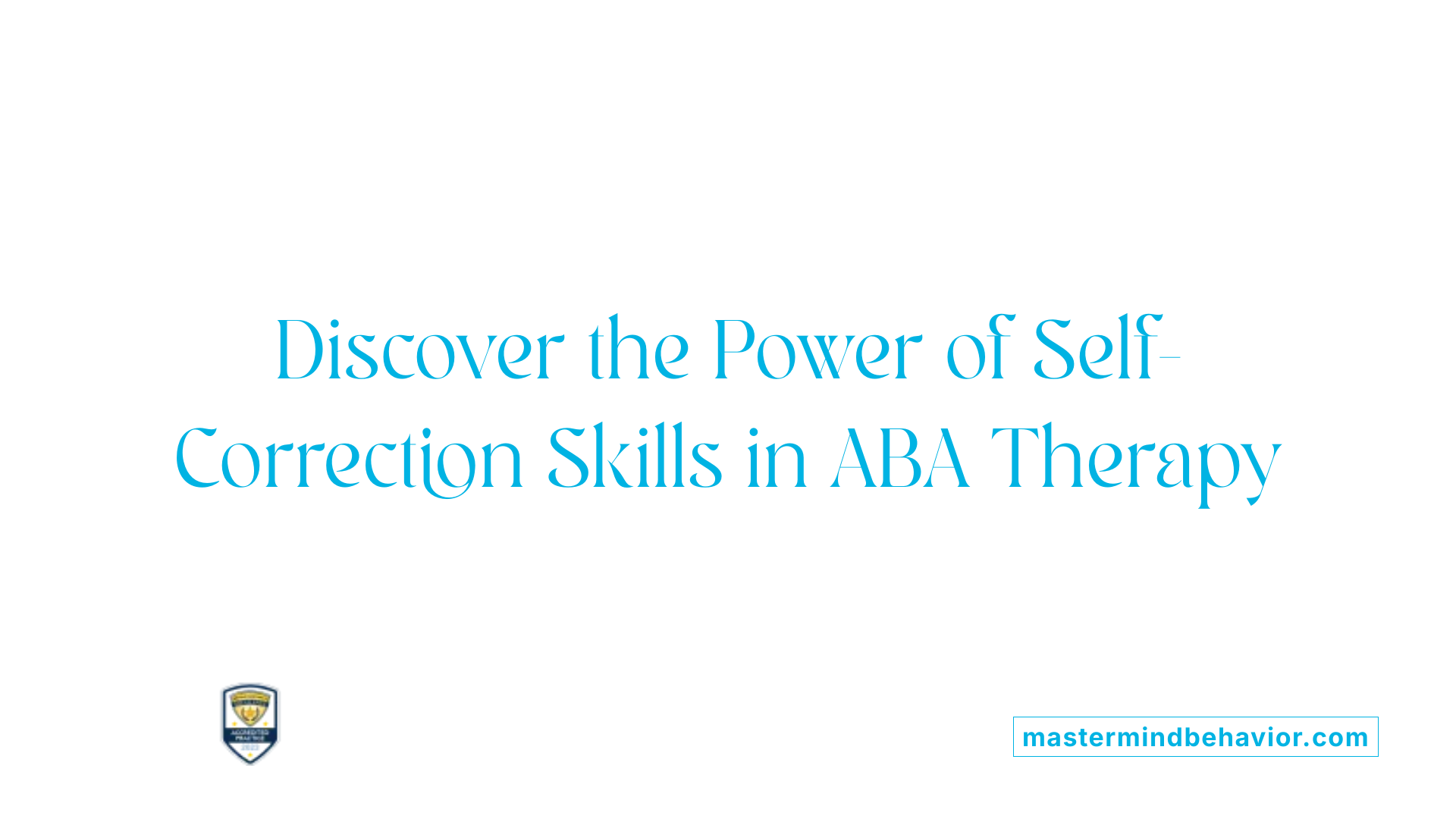
What are self-correction skills and why are they important in ABA therapy?
Self-correction skills refer to the ability of individuals to recognize their own errors and take corrective actions without external assistance. These skills are fundamental in learning and adaptive behavior because they empower children to become more autonomous in managing their actions.
In ABA therapy, developing self-correction abilities is considered a crucial goal. Through systematic teaching methods such as task analysis, prompting, modeling, and reinforcement, children learn to identify mistakes and fix them independently. This process fosters greater independence, reduces dependence on continuous supervision, and enhances the likelihood that learned behaviors will be generalized across different environments.
Building self-correction skills not only supports skill acquisition but also encourages persistence and confidence. When children learn to manage their mistakes, they are more motivated to participate actively in learning activities and are less likely to become frustrated or abandon tasks.
Furthermore, these skills contribute to long-term maintenance of behaviors and promote self-regulation. As children progress, they develop greater self-awareness, allowing them to monitor their actions and adjust as needed, which is essential for self-management.
Overall, integrating self-correction strategies within ABA interventions significantly enhances a child's ability to learn efficiently, act independently, and carry skills into everyday situations, ultimately improving their quality of life.
The Foundations of ABA in Teaching Self-Correction
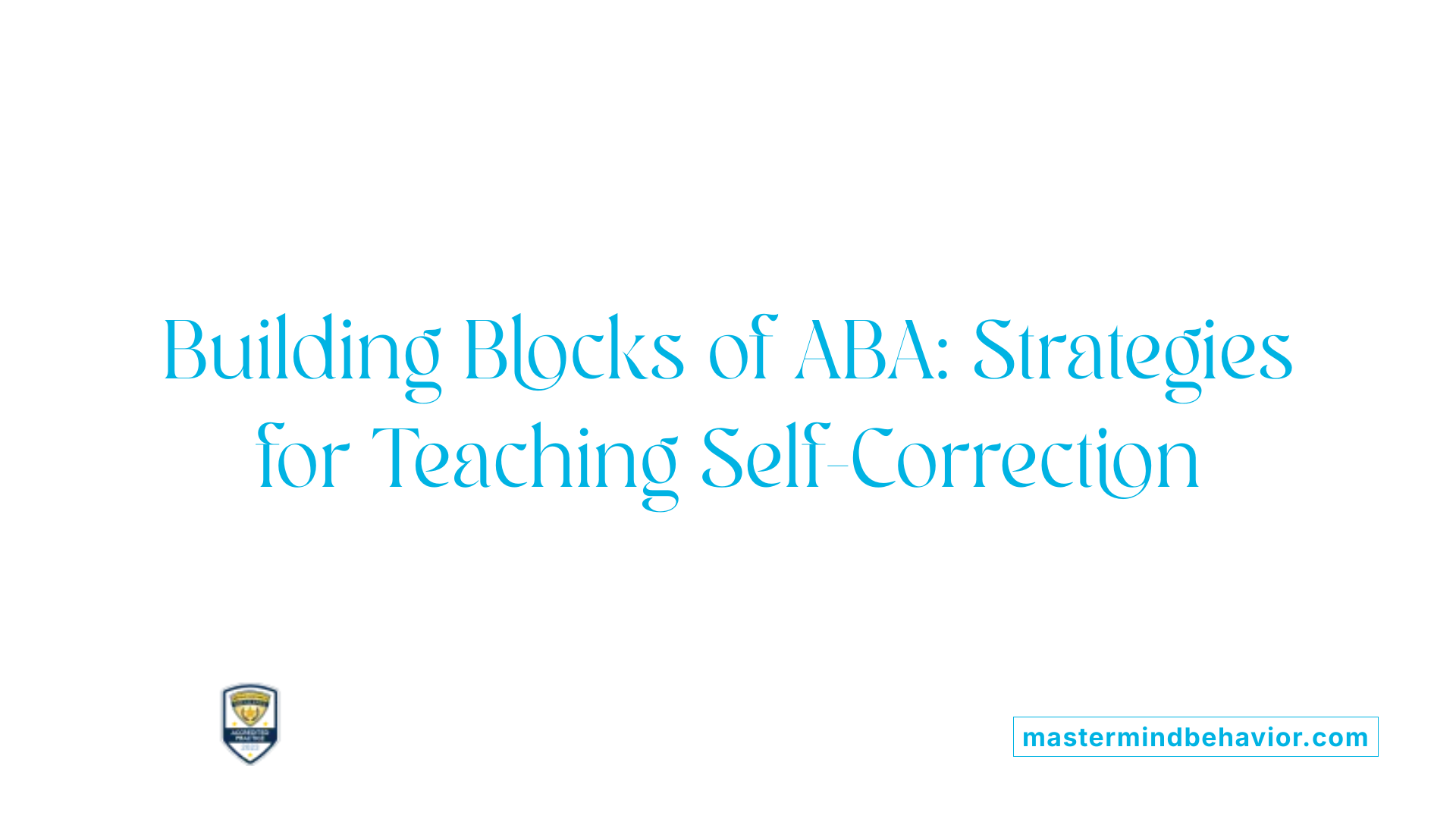
What are the main strategies that form the building blocks of ABA?
Applied Behavior Analysis (ABA) relies on several fundamental strategies that serve as the foundation for teaching a wide range of skills, including self-correction. Among these, reinforcement, prompting, modeling, and task analysis are central.
Reinforcement involves providing stimuli that increase the likelihood of desirable behaviors. This can be positive, such as praise or tangible rewards, or negative, which involves removing unwanted stimuli to encourage a specific response.
Prompting uses cues—such as gestures, verbal prompts, visual aids, modeling, or physical assistance—to help learners perform targeted skills correctly. Prompts are used carefully, with systematic fading to promote independence.
Modeling demonstrates how to perform a skill properly. This strategy provides visual or physical examples for learners to imitate, enhancing understanding and performance.
Task analysis breaks down complex skills into smaller, manageable steps. These are taught sequentially, often through methods like forward or backward chaining, making learning more attainable.
How can ABA techniques be used to teach self-correction skills?
Teaching self-correction involves training individuals to recognize and fix their mistakes independently. ABA techniques play a crucial role in this process.
One key approach is prompting and modeling. For example, a teacher or therapist might model the correct response and then provide prompts that guide the learner toward the correct behavior. Over time, prompts are gradually faded, encouraging the learner to perform the skill unaided.
Task analysis supports self-correction by outlining each step of a behavior, enabling learners to monitor their own performance and identify errors. Visual supports like schedules and self-monitoring checklists facilitate independence by helping individuals assess their actions.
Self-management strategies complement these techniques. They include goal setting, self-evaluation, and self-reinforcement, empowering individuals to regulate their behavior and correct errors without external prompts.
Systematic use of reinforcement for correct responses, along with deliberate fading of prompts, helps strengthen self-correction abilities. Tailoring interventions to each learner’s needs ensures these skills are learned effectively and maintained across different settings.
What are some core ABA techniques used in teaching self-correction?
| Technique | Description | Example | Purpose |
|---|---|---|---|
| Reinforcement | Providing stimuli to increase desired behavior | Praising a child after correct self-evaluation | To motivate and strengthen self-corrective behavior |
| Prompting | Using cues to assist in performing a skill | Giving a visual cue to remind to self-check work | To guide correct responses and build independence |
| Modeling | Demonstrating the correct behavior or response | Showing how to correct a mistake | To provide a clear example for imitation |
| Task Analysis | Breaking down behaviors into smaller steps | Listing steps for self-monitoring a routine | To enable learners to recognize and correct errors |
| Prompt Fading | Gradually reducing prompts to promote independence | Moving from physical prompts to visual cues | To encourage autonomous self-correction |
| Self-management strategies | Teaching learners to evaluate and reinforce their own behavior | Using checklists to monitor behavior | To foster self-regulation and independence |
How is data collection essential in ABA for self-correction?
Effective ABA interventions rely on ongoing data collection to monitor progress and adjust strategies. Data helps determine if self-correction techniques are successful and guides decision-making for future instruction. Regular assessments and recording of responses ensure that interventions are individualized, effective, and leading to meaningful behavior change.
Modeling Techniques That Foster Self-Monitoring and Correction
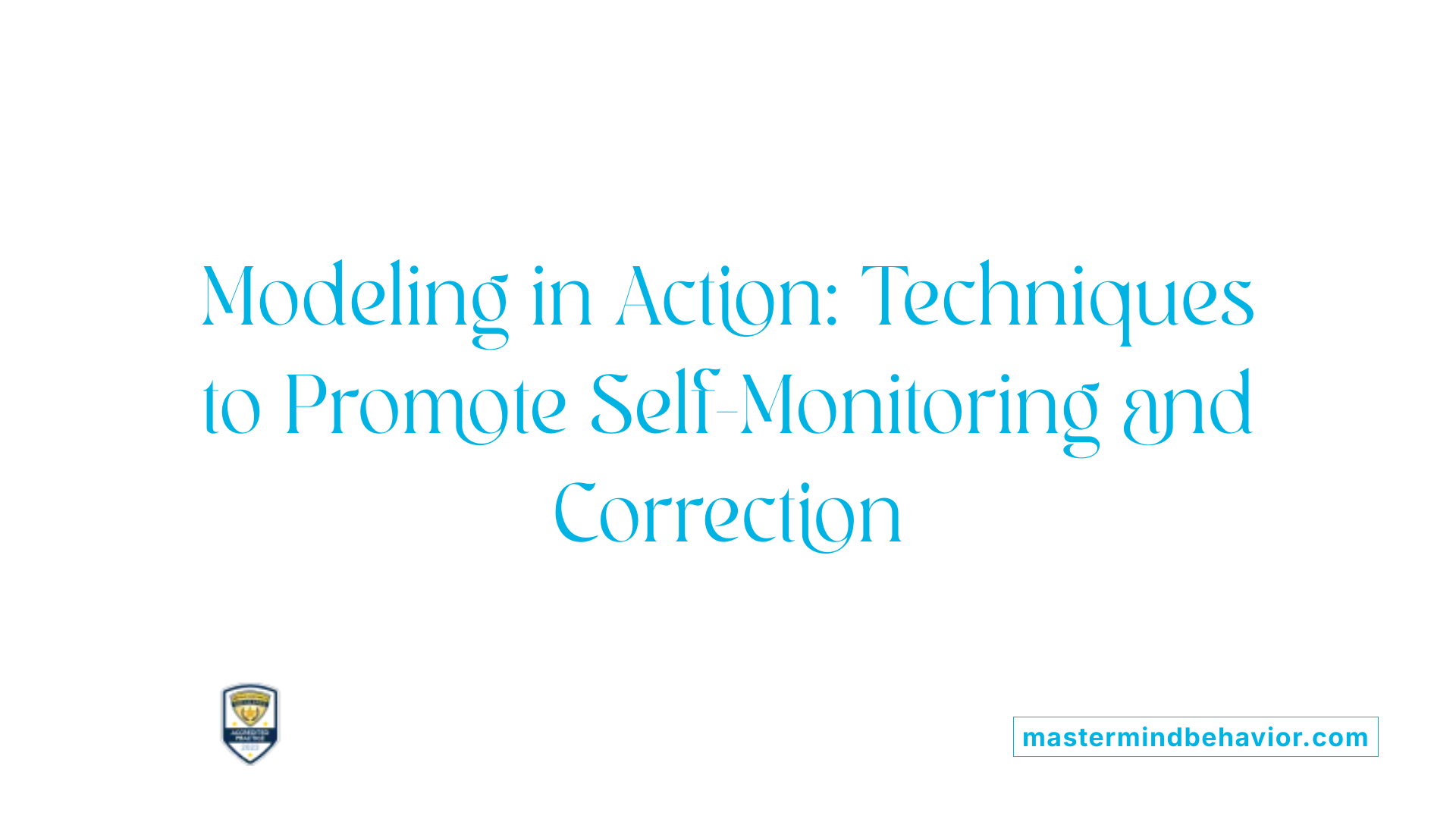
What modeling techniques in ABA can promote self-correction?
Modeling plays a crucial role in helping children with autism develop self-monitoring and correction skills. Several techniques are highly effective in teaching individuals to recognize and fix their errors independently.
Video modeling is a popular approach where learners watch videos of themselves or others successfully performing a skill. For example, a student might see a video of themselves brushing their teeth correctly, which reinforces proper technique. When a mistake occurs, the individual can compare their current performance with the video, encouraging self-awareness and correction.
Live demonstration involves a practitioner or peer physically showing how to perform a skill correctly. By observing these live examples, learners learn to imitate the correct behavior and develop the ability to notice their own errors during practice.
Peer modeling leverages interactions with peers to promote social and communication skills. For instance, a child might observe a peer requesting and receiving a toy appropriately, then attempt to replicate this behavior and self-correct if necessary.
Role modeling demonstrates how to handle specific social or emotional situations. For example, a teacher might show how to express frustration calmly. Learners observe these demonstrations and later utilize self-correction when faced with similar scenarios.
Direct instruction modeling involves a teacher explaining each step of a task while performing it, narrating actions aloud. This technique helps learners understand the process and recognize errors, promoting self-correction during independent performance.
Partial modeling shows only parts of a task, encouraging learners to complete the rest of the task independently. For example, demonstrating pouring cereal but allowing the learner to complete other steps, fostering autonomy and error detection.
Situational modeling simulates real-life social interactions, like saying “Excuse me” after being bumped. These models help individuals develop social awareness and correct responses in authentic settings.
How do these techniques promote self-critique?
Incorporating these modeling methods provides clear visual and contextual examples of correct responses. This exposure helps learners internalize what correct performance looks like, enabling them to compare their own behavior against these models.
By regularly observing and practicing modeled behaviors, individuals learn to recognize mistakes and self-correct, fostering independence. Promoting self-efficacy through self-monitoring reduces reliance on prompts and increases confidence in managing behaviors.
Utilizing a combination of these modeling techniques creates a comprehensive learning environment that supports the development of self-correction skills, crucial for ongoing social, communication, and daily living improvements.
Errorless Teaching for Self-Correction Development
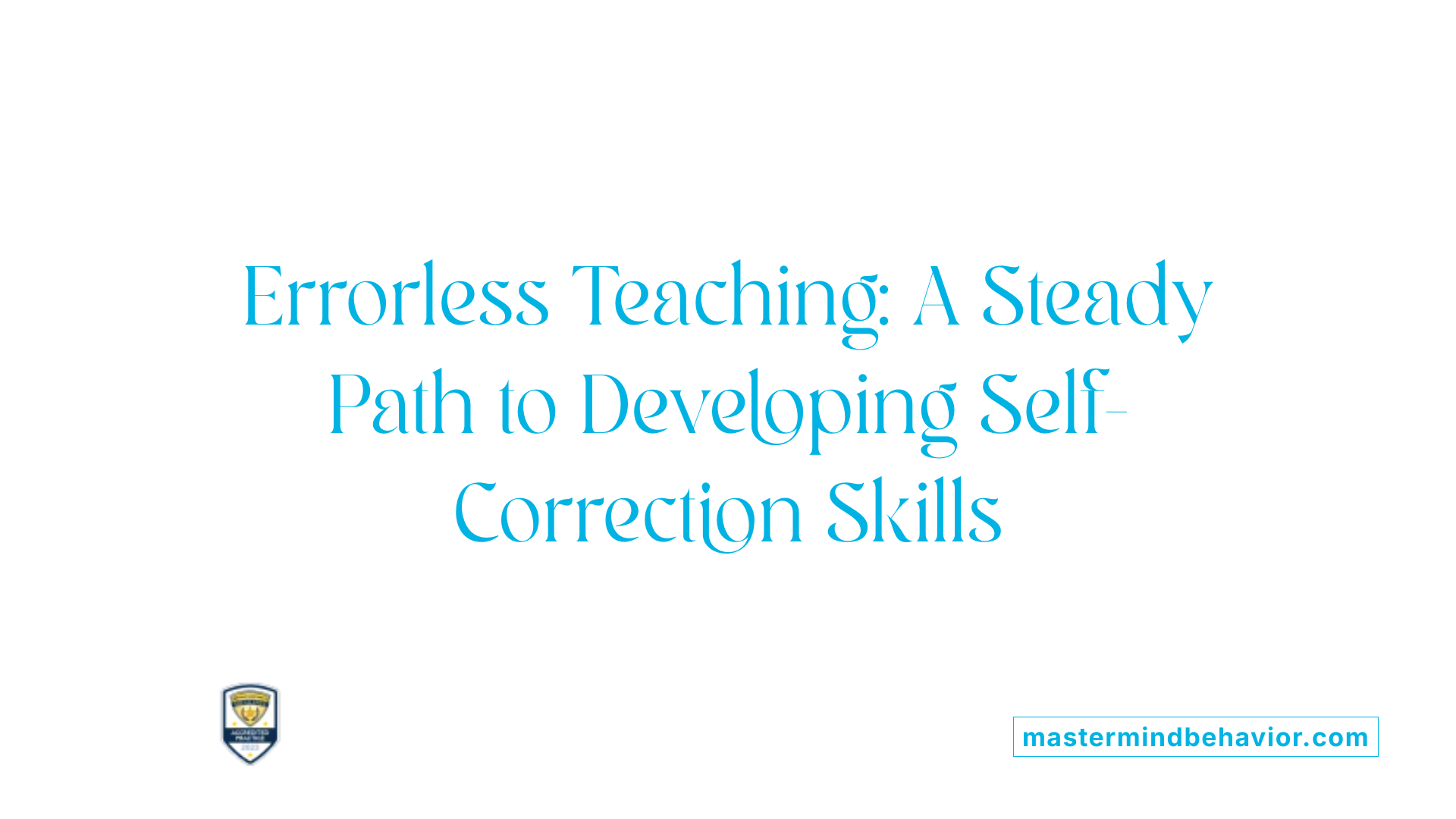
What are errorless teaching methods for developing self-correction skills?
Errorless teaching methods are designed to guide learners, especially children with autism, toward correct responses while reducing mistakes during learning. This approach relies on the strategic use of prompts and systematic fading techniques that prevent errors before they occur.
Prompts can include physical assistance, modeling, visual cues, or verbal hints. These prompts are initially intrusive to ensure the learner responds correctly. Over time, they are gradually lessened using hierarchies such as most-to-least prompting or time delay methods. For example, a teacher might first physically guide a child's hand to complete a task and then gradually remove the physical prompts, encouraging the child to perform independently.
Reinforcement plays a vital role. When the learner responds correctly, they receive positive reinforcement, such as praise or a preferred activity, which strengthens the correct behavior and boosts confidence. This process minimizes learner frustration, a common issue when mistakes are frequent or poorly managed.
The key advantage of errorless teaching is its preventive nature. By designing situations where errors are unlikely or unlikely to occur, it creates a positive, low-stress learning environment. This method is particularly effective for individuals with communication challenges or limited cognitive abilities, as it supports skill acquisition without the discouragement that can come from frequent errors.
Overall, errorless teaching emphasizes guiding learners toward success, systematically reducing prompts as competence increases, and reinforcing correct responses. This approach not only fosters independent self-correction but also accelerates the development of essential skills, including social, communication, and daily living tasks.
Effective ABA Strategies for Promoting Self-Correction
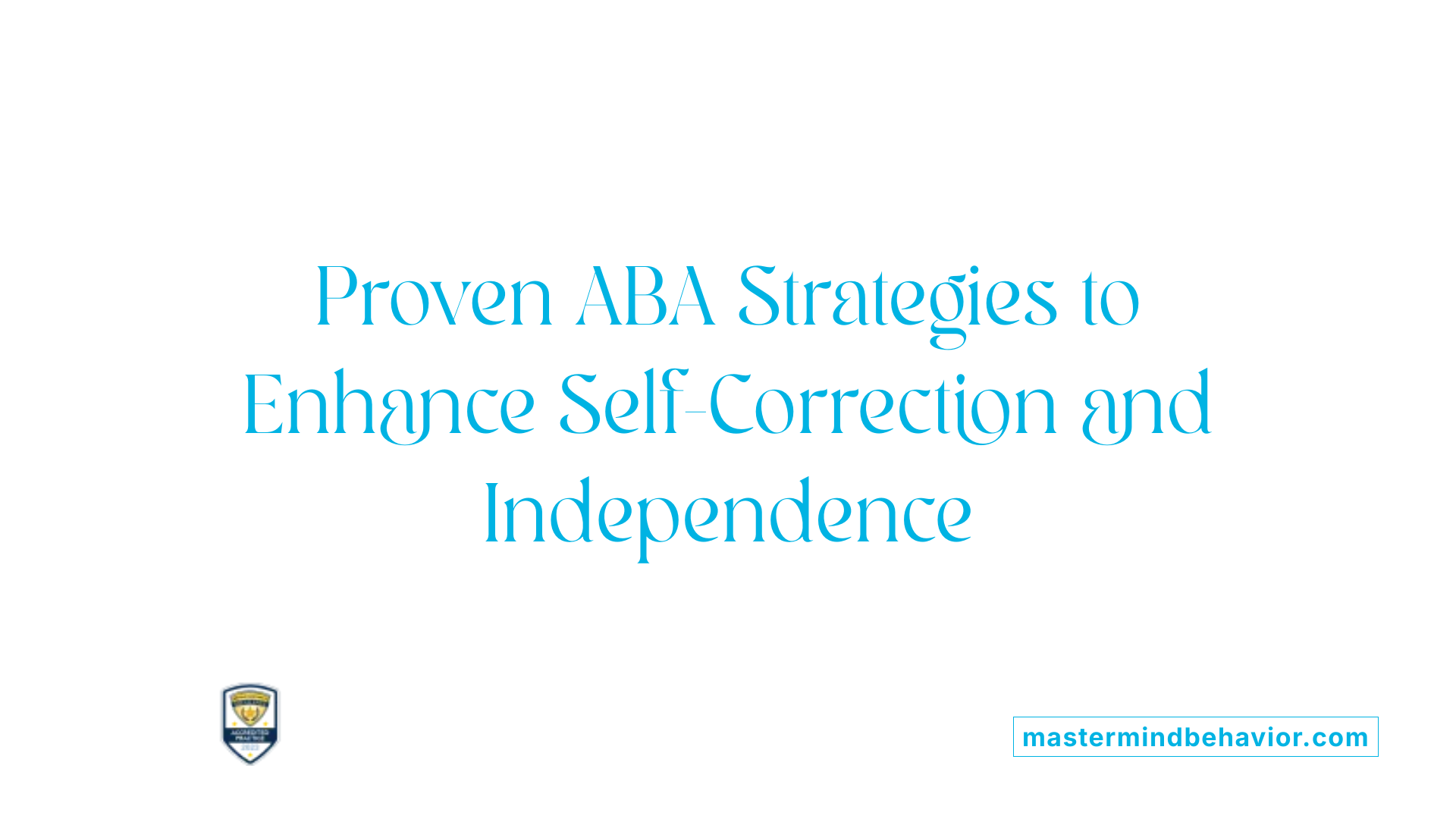
What are evidence-based ABA strategies for teaching self-correction?
Teaching self-correction in children with autism spectrum disorder (ASD) involves a variety of structured, proven methods based on applied behavior analysis (ABA). A core approach is task analysis, which breaks complex skills into smaller, manageable steps. This allows learners to acquire skills gradually, practicing each part until mastery.
Prompting and modeling are essential for guiding learners through new tasks. Prompts—such as visual cues, gestures, or physical assistance—are used initially and then systematically faded as the learner gains independence. Modeling demonstrates the correct way to perform a skill, especially useful when combined with prompting and reinforcement.
Self-management techniques are vital for fostering independence. These include teaching learners to set goals, monitor their own behaviors, and evaluate their performance. Self-recording or self-monitoring allows individuals to track their progress and recognize when corrections are needed.
Visual supports like schedules, routines, emotion cards, and social stories significantly enhance understanding and facilitate self-correction. They provide visual cues that help children recognize appropriate responses, manage emotions, and follow routines independently.
Positive reinforcement encourages desired behaviors and self-corrective actions. Immediate rewards, whether social praise or tangible reinforcers, increase motivation and engagement.
Error correction protocols are also important. When mistakes occur, promptly correcting errors without negative comments reinforces learning. Techniques like most-to-least prompting and errorless teaching ensure responses are correct from the start, minimizing frustration and promoting confidence.
Collaborating with trained professionals such as board-certified behavior analysts (BCBAs) and therapists ensures that strategies are personalized, effective, and implemented correctly across home, school, and community environments. By combining these evidence-based practices, children with ASD can develop strong self-correction skills that support their ongoing learning and independence.
Research Evidence Supporting ABA for Self-Correction and Independence
What research supports the use of ABA techniques for teaching self-correction and independence?
Over the past five decades, extensive research has firmly established the effectiveness of applied behavior analysis (ABA) in teaching self-correction skills and fostering independence, especially in individuals with autism spectrum disorder (ASD). Empirical investigations have shown that ABA strategies such as self-management, discrete trial training, shaping, and naturalistic intervention methods lead to significant improvements in adaptive behaviors.
Studies consistently report positive outcomes in areas like communication, social interaction, daily living skills, and academic performance, highlighting the broad applicability of ABA-based approaches. These interventions are tailored to individual needs, allowing for flexibility and targeted teaching, which further enhances their success.
Major organizations endorse ABA as a scientifically backed method. For instance, Autism Speaks, the American Psychological Association, and the U.S. Surgeon General recognize ABA as one of the most effective treatments for promoting independence in children and adults with ASD. Their endorsements are based on numerous controlled studies and meta-analyses that confirm ABA's capacity to reinforce desired behaviors and reduce problematic ones.
Furthermore, research underscores that intensity and customization of ABA programs matter. Children and learners who participate in individualized treatment plans with appropriate reinforcement and prompting techniques tend to show greater gains in self-correction skills and independence.
In summary, the consensus from decades of rigorous research confirms that ABA techniques are highly effective tools for teaching self-correction and independence. These methods, supported by leading health and educational authorities, continue to evolve based on scientific evidence, ensuring optimal outcomes for learners with ASD and related developmental conditions.
| Aspect | Description | Supporting Evidence |
|---|---|---|
| Research Duration | 50+ years | Longitudinal studies affirm long-term effectiveness |
| Types of Studies | Controlled trials, meta-analyses | Show consistent positive outcomes |
| Endorsing Organizations | Autism Speaks, APA, U.S. Surgeon General | Official endorsements based on extensive data |
| Focus Areas | Communication, social skills, daily living | Demonstrated improvements across multiple domains |
| Program Adaptability | Individualized plans | Tailored interventions yield better results |
| Outcomes | Increased independence, reduced problematic behaviors | Empirical evidence supports these goals |
This accumulating body of research emphasizes that ABA remains a cornerstone in evidence-based practices aimed at teaching self-correction and independence among individuals with ASD.
Enhancing Teaching Strategies for Children with Autism
How can ABA methods enhance teaching strategies for children with autism?
Applied Behavior Analysis (ABA) offers powerful tools for developing effective educational strategies tailored to children with autism. It emphasizes individualized, data-based interventions that focus on key skills such as communication, social interaction, and independence.
Core ABA techniques include reinforcement, which strengthens desired behaviors; prompting, which guides correct responses; modeling, which demonstrates behaviors; and task analysis, which breaks down complex skills into manageable steps. These strategies are adaptable, allowing educators and therapists to design programs that suit each child's unique strengths and challenges.
In addition to discrete trial teaching (DTT), natural environment training (NET) is used to teach skills within real-world settings. This approach capitalizes on the child's interests, making learning naturally engaging. Pivotal Response Training (PRT) further emphasizes motivation and social abilities, promoting intrinsic interest in social interactions and language.
Parental involvement is a crucial element. Training caregivers to implement ABA techniques ensures consistency across home and school settings, enhancing skill generalization and maintenance.
Overall, ABA's systematic approach enhances not only skill acquisition but also promotes greater independence, socialization, and emotional growth. Its evidence-based methods help children with autism reach their full potential in a supportive, motivating environment.
| Strategy | Explanation | Application Examples |
|---|---|---|
| Reinforcement | Olfactory or social rewards to encourage behaviors | Praising a child for completing a puzzle |
| Prompting | Cues to support correct responses | Verbal or physical prompts to build independence |
| Modeling | Demonstrating desired behaviors | Showing proper social greetings |
| Task Analysis | Breaking tasks into steps | Teaching handwashing through sequential steps |
| Naturalistic ABA | Teaching in natural settings, using interests | Play sessions to develop language and social skills |
| Parental Training | Educating parents on ABA techniques | Home-based reinforcement for daily routines |
This integrated approach underpins the success of interventions, fostering meaningful progress in children with autism across diverse environments.
Summary and Future Directions in ABA Self-Correction Teaching
How can ABA techniques be used to teach self-correction skills?
Applied Behavior Analysis (ABA) offers a variety of strategies to develop self-correction skills in individuals with autism and other developmental disorders. Central techniques include prompting, modeling, and reinforcement, which guide learners to recognize and adjust their behaviors effectively.
Prompting, such as visual or verbal cues, helps individuals become aware of correct responses and correct errors when they occur. Over time, prompts are systematically faded through techniques like time delay prompting or most-to-least prompting to encourage independence. Modeling provides clear demonstrations of appropriate behaviors, serving as a template for learners to imitate and self-correct.
Task analysis plays a crucial role by breaking down complex behaviors into smaller, manageable steps. This allows learners to monitor their own performance step-by-step, making self-correction more attainable. Additionally, visual supports like schedules, checklists, and self-monitoring charts promote autonomous behavior by helping individuals assess their actions and identify mistakes.
Self-management strategies, including setting personal goals, self-evaluating, and applying self-rewards, foster a sense of ownership over behavior change. These methods teach learners to independently identify errors and implement corrections without external prompts.
Importantly, tailoring interventions to each learner’s specific needs enhances the effectiveness of self-correction training. Customized programs ensure skills are learned appropriately and can be generalized across different settings, promoting long-term independence.
What are the future directions for ABA in teaching self-correction?
Emerging research emphasizes the importance of integrating technology, such as digital apps and virtual reality, to foster self-monitoring and correction skills. Wearable devices and interactive software can provide real-time feedback, making self-correction more engaging and accurate.
Another promising direction involves enhancing caregiver and teacher training. Equipping those in daily contact with learners ensures consistency and reinforcement of self-correction behaviors across environments.
Furthermore, studies are exploring the incorporation of naturalistic teaching approaches that embed self-correction in everyday, meaningful activities. This increases motivation and contextual relevance, resulting in better generalization.
Research also focuses on measuring long-term outcomes and the quality of life improvements resulting from self-correction interventions, emphasizing functional independence.
What is the importance of individualized programs?
Customizing ABA interventions for each learner is fundamental. Individualized programs accommodate unique learning styles, behavioral challenges, and preferences, maximizing engagement and success. Continuous data collection and assessment help professionals adapt strategies to ensure progress and maintain motivation.
How does ongoing research inform practice?
Advances in understanding the science of learning and behavior support the development of more effective, efficient, and user-friendly interventions. Ongoing studies improve techniques such as prompt fading, reinforcement schedules, and self-management tools, directly impacting clinical practice.
What about training for caregivers?
Empowering parents, teachers, and therapists through comprehensive training fosters consistent application of ABA techniques. Such training ensures that self-correction skills are reinforced in all settings, promoting skill transfer and reducing problematic behaviors.
| Strategies | Methods | Future Implications |
|---|---|---|
| Prompting | Visual, verbal, physical cues | Enhanced fading methods and technology integration |
| Modeling | Live, video, peer, role | Increased use of virtual and augmented reality |
| Reinforcement | Tangible, social, schedules | Personalized and dynamic reinforcement plans |
| Self-Management | Goal setting, self-monitoring | Digital tools for tracking progress |
| Data Collection | Ongoing assessment tools | Better analytics and adaptive programs |
Overall, future directions in ABA focus on leveraging new technologies, strengthening caregiver involvement, and customizing interventions to support lifelong self-correction and independence.
The Path Forward in Self-Correction Training
Incorporating self-correction skills within ABA therapy offers a pathway to greater independence for children with autism. Evidence-based techniques like task analysis, prompting, modeling, and errorless teaching form the foundation of effective instruction. As research continues to evolve, emphasis on individualization, caregiver training, and naturalistic interventions will further enhance outcomes. These strategies not only promote autonomous learning but also empower children to become confident, self-regulated individuals capable of navigating various life situations, thereby improving their overall quality of life.
References
- Page 3: Foundational Strategies - IRIS Center
- Discover 8 Examples of Modeling in ABA Therapy
- FACT SHEET – ERRORLESS TEACHING
- ABA Terminology
- Self-management (SM) - ---EBP Brief Packet
- Errorless Learning for Children With Autism [Ultimate Guide]
- 10 Evidence-Based ABA Therapy Techniques to Consider
- ABA Therapy Strategies: Benefits For Children With Autism
Recent articles

The Role of Reinforcement in Shaping Positive Behaviors in Autism Treatment
Harnessing Reinforcement to Foster Positive Change in Autism Therapy

The benefits of community outings in ABA therapy
Harnessing Real-World Settings to Empower Children with Autism

How ABA Therapy Addresses Tantrums and Meltdowns in Children with Autism
Transformative Strategies in Autism Behavior Management

How ABA Therapy Can Help with Impulse Control and Decision-Making
Enhancing Self-Control and Decision-Making in Autism Through ABA

How ABA Therapy Can Help with Impulse Control and Decision-Making
Enhancing Self-Control and Decision-Making in Autism Through ABA

How ABA Therapy Enhances Communication and Social Skills in Children
Unlocking Social Potential: The Power of ABA Therapy for Children with Autism



